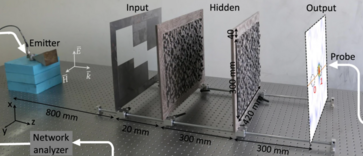An optical neural network is a physical implementation of an artificial neural network with optical components. Early optical neural networks used a photorefractive Volume hologram to interconnect arrays of input neurons to arrays of output with synaptic weights in proportion to the multiplexed hologram's strength.[2] Volume holograms were further multiplexed using spectral hole burning to add one dimension of wavelength to space to achieve four dimensional interconnects of two dimensional arrays of neural inputs and outputs.[3] This research led to extensive research on alternative methods using the strength of the optical interconnect for implementing neuronal communications.[4]
Some artificial neural networks that have been implemented as optical neural networks include the Hopfield neural network[5] and the Kohonen self-organizing map with liquid crystal spatial light modulators[6] Optical neural networks can also be based on the principles of neuromorphic engineering, creating neuromorphic photonic systems. Typically, these systems encode information in the networks using spikes, mimicking the functionality of spiking neural networks in optical and photonic hardware. Photonic devices that have demonstrated neuromorphic functionalities include (among others) vertical-cavity surface-emitting lasers,[7][8] integrated photonic modulators,[9] optoelectronic systems based on superconducting Josephson junctions[10] or systems based on resonant tunnelling diodes.[11]
- ^ Qian, Chao; Lin, Xiao; Lin, Xiaobin; Xu, Jian; Sun, Yang; Li, Erping; Zhang, Baile; Chen, Hongsheng (2020). "Performing optical logic operations by a diffractive neural network". Light: Science & Applications. 9 (59): 59. Bibcode:2020LSA.....9...59Q. doi:10.1038/s41377-020-0303-2. PMC 7154031. PMID 32337023.
- ^ Wagner K, Psaltis D (1988). "Adaptive optical networks using photorefractive crystals". Appl. Opt. 27 (9): 1752–1759. Bibcode:1988ApOpt..27.1752P. doi:10.1364/AO.27.001752. PMID 20531647.
- ^ Weverka R, Wagner K, Saffman M (1991). "Fully interconnected, two-dimensional neural arrays using wavelength-multiplexed volume holograms". Optics Letters. 16 (11): 826–828. Bibcode:1991OptL...16..826W. doi:10.1364/OL.16.000826. PMID 19776798.
- ^ Wagner K, Psaltis D (1993). "Optical neural networks: an introduction by the feature editors". Appl. Opt. 32 (8): 1261–1263. Bibcode:1993ApOpt..32.1261W. doi:10.1364/AO.32.001261. PMID 20820259.
- ^ Ramachandran R, Gunasekaran N (2000). "Optical Implementation of Two Dimensional Bipolar Hopfield Model Neural Network (Scientific Note)" (PDF). Proceedings-National Science Council Republic of China Part a Physical Science and Engineering. 24 (1): 73–8. Archived from the original (PDF) on 12 October 2004.
- ^ Duvillier J, Killinger M, Heggarty K, Yao K, de Bougrenet de la Tocnaye JL (January 1994). "All-optical implementation of a self-organizing map: a preliminary approach". Applied Optics. 33 (2): 258–66. Bibcode:1994ApOpt..33..258D. doi:10.1364/AO.33.000258. PMID 20862015.
- ^ Hejda M, Robertson J, Bueno J, Alanis J, Hurtado A (2021-06-01). "Neuromorphic encoding of image pixel data into rate-coded optical spike trains with a photonic VCSEL-neuron". APL Photonics. 6 (6): 060802. Bibcode:2021APLP....6f0802H. doi:10.1063/5.0048674. ISSN 2378-0967.
- ^ Robertson J, Hejda M, Bueno J, Hurtado A (April 2020). "Ultrafast optical integration and pattern classification for neuromorphic photonics based on spiking VCSEL neurons". Scientific Reports. 10 (1): 6098. Bibcode:2020NatSR..10.6098R. doi:10.1038/s41598-020-62945-5. PMC 7142074. PMID 32269249.
- ^ George JK, Mehrabian A, Amin R, Meng J, de Lima TF, Tait AN, et al. (February 2019). "Neuromorphic photonics with electro-absorption modulators". Optics Express. 27 (4): 5181–5191. arXiv:1809.03545. Bibcode:2019OExpr..27.5181G. doi:10.1364/OE.27.005181. PMID 30876120. S2CID 80625696.
- ^ Shainline JM (January 2020). "Fluxonic Processing of Photonic Synapse Events". IEEE Journal of Selected Topics in Quantum Electronics. 26 (1): 1–15. arXiv:1904.02807. Bibcode:2020IJSTQ..2627473S. doi:10.1109/JSTQE.2019.2927473. ISSN 1077-260X. S2CID 102352120.
- ^ Romeira B, Javaloyes J, Ironside CN, Figueiredo JM, Balle S, Piro O (September 2013). "Excitability and optical pulse generation in semiconductor lasers driven by resonant tunneling diode photo-detectors". Optics Express. 21 (18): 20931–40. Bibcode:2013OExpr..2120931R. doi:10.1364/OE.21.020931. hdl:10400.1/11954. PMID 24103966. S2CID 480070.

